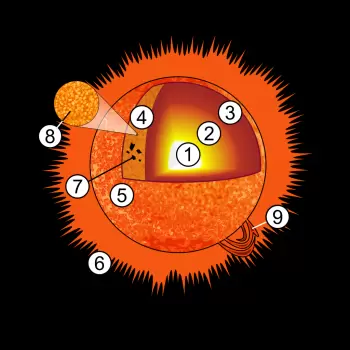
The Sun is the unique star in our Solar System, providing light energy to all solar system’s planets. The structure of the Sun is represented in different spherical layers that are difficult to determine with a physical boundary.
The different layers or parts of the Sun are determined by the physical function they perform. Currently, astrophysics has a model of the solar structure made up of six layers divided into two groups: the inner and outer layers of the Sun.
The sun's atmosphere comprises the only layers of the Sun that can be observed directly are the outer layers: the photosphere, chromosphere, and corona. These three layers make up the solar atmosphere.
Starting from the Sun’s interior core and moving outward, the layers of the Sun are:
1. Solar core
The solar sun's core is where nuclear fusion reactions are generated, producing light and heat. Therefore, it is where all energy is generated. It is composed of gas that appears as plasma due to high temperature and pressure due to its magnetic field. High pressure is necessary for nuclear fusion to occur.
Nuclear reactions are the source of energy generating more energy than 80% of the other stars in the Milky Way.
Thermal energy has been transmitted through electromagnetic waves for 4,603 billion years. This phenomenon of electromagnetic waves is solar radiation.
2. Radiative zone of the Sun
In the area outside the solar core, the radiative zone receives the energy generated inside by radiation. This region of the Sun is composed of plasma, that is, large amounts of ionized hydrogen and helium.
In this area, the temperature decreases as we move away from the nucleus. These temperature differences favor the photons moving outwards.
3. Convective zone of the Sun
It is located above the radiant area. Solar gases are no longer ionized, and photons are easily absorbed. Consequently, the photons are no longer transported by radiation.
The transport of energy is carried out by convection. Heat is transported in an inhomogeneous and turbulent manner by the fluid itself.
Turbulent convective sections are formed, in which hot and light gas patch up to the photosphere. In the photosphere, the solar atmosphere becomes transparent to radiation, and the hot gas gives up its energy in the form of visible light.
4. Photosphere
The first of the outer layers of the Sun is called the Photosphere. It generates almost all of the visible light that the star emits into space. For this reason, it is considered the surface of the Sun.
In the photosphere, sunspots are formed, which are dark spots on the solar surface due to their much lower temperature. Most solar flares appear around sunspots.
The width of the photosphere is approximately 400 kilometers, and the temperature varies between 7,500 and 4,700 Kelvin, decreasing as it moves away from the nucleus.
5. Chromosphere
The chromosphere is believed to be 2,000 to 3,000 kilometers wide. As it moves away from the nucleus, the density of the chromosphere decreases, and the temperature increases from 4,500 to 100,000 degrees Celsius.
6. Transition Region
This region is a very thin layer between the chromosphere and the outer layer of the Sun: the corona (60 miles / 100 km). In this transition region, the temperature rises abruptly from about 8000 to about 500,000 K.
7. Corona, the outer layer of the Sun
It is the outer layer of the san, and its width is a few million kilometers. The total luminosity is only half the luminosity of the full moon.
When a solar eclipse occurs, the circle that we can see around the moon covering the Sun is the Corona.
The density of matter at the base of the corona is 109 atoms per square centimeter.
The temperature of the corona generally oscillates around one million kelvins.
The solar wind is a flow of charged particles (primarily high-energy protons, 500 keV ) that arise from the solar corona.


